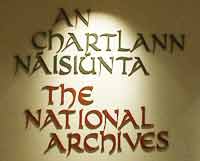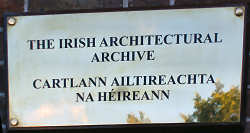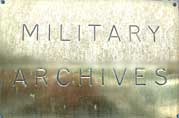Data Sources
Dublin City Archive

DCA Website
The Dublin City Archive reading room is situated above the public library in Pearse Street. The premises have been recently renovated, are a pleasure to work in, and the staff are very helpful.
While the archive specialises in material related to Dublin, some of the available sources refer to the State or even the Island as a whole.
The principal sources I have drawn on are:
- Indexes to the Civil Records of Births, Marriages and Deaths. These are countrywide and are available on microfilm. They were copied onto film by the Mormons and are a huge national asset. You need to have some idea of the name and date to start with. You can then get coordinates from the indexes which enable you to specify particular certs for copying from the GRO (see below). They cover the years 1864 to 1950, along with non-catholic marriages for 1845-64. You might encounter the odd missing film, in which case you need to check out the hard copy of the index in the GRO.
- Thoms directories. These refer principally to Dublin (city and county). The series is available from the mid 1800s. They are invaluable for tracing people's movements around the city. I used them extensively in the course of local history research in the early 1970s on Ballybrack in the County Dublin, but they have proved equally useful in the Dublin segment of this present exercise which concentrates mainly on the Liberties area of Dublin City.
- Digitised Ordnance Survey 6" (circa 1840) and 25" (circa 1900) maps of the whole country. These are very useful for cross matching with
- Thoms insofar as Dublin City is concerned
- Photographs nationwide, paricularly urban.
- Voter registers (digitised) for Dublin for 1937-1964. These can be a very useful complement to Thoms for which you need an address in the first place. The voter registers can be searched by name (person or street) and will give you addresses and names of people over 21 years of age. The register can be particularly useful for finding people who are moving around the city and can also track ages as people reach 21 and appear at an address for the first time. Unfortunately the series is limited to Dublin city and only covers a 30 year period.
- Individual household returns for the Dublin area from the 1901 and 1911 censuses of population on microfilm. [returns for the country generally are available at the National Archive - see below]
- Hardcopy and/or microfilm of Irish newspapers going way back. There is also free access to a digitised search of many Irish newspapers. This service is also available on a commercial basis on the internet. Unfortunately the digital search function is appalling. It is, nevertheless, worth trying a search, just in case. In any event, if you already have a date, the page images are good and can be printed down. The Irish Times digital archive is also available here.
- There is also a series of digitally searchable databases of Dublin parish records (C of I and RC) which are being continually expanded.
- RIC service record ledgers. If, like me, you have an RIC member in the family going back you can count yourself lucky, at least from a genealogical point of view. Jim Herlihy has done a fantastic service by assembling an alphabetical index of RIC members with their service numbers. These numbers can then be used to trace the record of the member. Records are on microfilm in the DCA. You can get a lot of incidental information from these, including age, height, date of marriage, previous occupation, rewards or reprimands, length of service, date and amount of pension.
National Archives

NA Website
The National Archives are situated in Bishop Street beside the DIT at the site of the old Jacob's factory.
They are a vast repository of State papers in particular but my use of them has been fairly limited to date given the availability of some national material in the DCA.
So far I have accessed:
- 1901 and 1911 Census returns for Mayo and Offally
- Coroner's inquest register for Dublin and inquest reports for Mayo
- Chief Secretary's Papers - Dublin Metropolitan Police items
- Wills, including those of Irish WWI soldiers
General Register Office
Research Room

GRO Website
The General Register Office, formerly located in Lombard St., is now in the Irish Life Centre (Abbey St./Beresford Place) and is the source of Birth, Marriage and Death certificates. In addition to its normal function of providing legally validated certs to the public it maintains a research room where photocopies of register entries can be had for €4 each compared with the €12 or €16 for the legal certs.
You can also search hard copy indexes of the birth, death and marriage records (for €2 for volumes for 5 consecutive years). These are available in the DCA on microfilm for free , thanks to our Mormon brothers from Utah (pre-1950).
Certs can provide a lot of information which may appear peripheral to the event being recorded but which can be of enormous help to the researcher. For example:
- Birth certs provide addresses for particular years which help to pin down family movement.
- Marriage certs provide the names and occupations of the fathers of the bride and groom.
- Death certs provide a place of death, cause of death and by whom the death was reported.
See here for some examples in my own case.
Cemeteries

for example: Glasnevin
Cemeteries can be an absolute mine of information (no pun intended). For example, if you have a date of death for one family member and know where they were buried, you can visit the cemetery, examine the tombstone, and often get dates of death, or ages, for other family members.
Glasnevin will provide a full list of the occupants of any grave, their ages at death, addresses, and ownership of the grave. Searches post-1900 are accessed from the cemetery's computerised database, while information on burials pre-1900 is retrieved from the manual system. There is a €30 search fee but the circumstances under which it is charged are not clear. All written requests for information appear to incur the fee, but post-1900 information, and even a printout, might be provided by staff at the office in response to a request in person. You can always turn up at the cemetery and ask for the number of a grave, once you have a name and a date of death. You can then check out the tombstone, but the information there may be a lot less than on the cemetery's database.
I had to resort to a paid search in the case of Joseph the Carpenter, not knowing if he was buried in Glasnevin at all. Fortunately I got a hit and a bonus, if that's not too insensitive a term in the circumstances. I discovered an additional newborn and a young child, and, as a result, was able to date his marriage ten years earlier than I had previously thought.
My own experience so far in this area is here.
National Photographic Archive

NPA Website
This used to be the photographic end of the National Library in Kildare St. It houses a vast collection of photos taken all over the country.
I used to view the original Lawrence Collection glass plates in the course of my local history research in the early 1970s. The facility is now marketed as a separate service and is located in Temple Bar.
You can follow up a certain amount of stuff online but you are probably better going in to the reading room and checking out any photos you think might be of interest.
Copies can be ordered for €12 and take upward of 3 weeks to appear.
Irish Architectural Archive

IAA Website
The Archive has an extensive collection of photos of the built environment in Dublin and throughout the country. It is particularly strong on monuments and public buildings. Photos of ordinary houses and streets are a bit hit and miss but you might strike lucky, particularly for houses which had been renovated and for which project/site photos would have been taken.
The archive is also now responsible for material relating to the Dublin Artizans Dwellings Company (DADC). This company was set up in the 1800s to construct good quality housing for letting at reasonable (but broadly commercial) rents to the artisan class. They built estates all over the city and the project was progressed in tandem with slum clearance undertaken by the Corporation.
As Thoms does not record occupiers of DADC housing estates separately, the rent/rate books of the company would have been a vital complement to the conventional street directory. Rumour has it that they did not survive the takeover of the residual DADC interest by another company in the 1980s. As the Corporation did not keep separate records of these tenants' names in its rates books this would mean that a vital source of information regarding a significant proportion of Dublin housing occupants, particularly in the centre city areas, would have been lost.
National Library

National Library Website
If you are going back beyond the mid 1800s you will have to delve into parish rather than civil records. This is much trickier as, unlike the civil records, they are not indexed on a national basis. You will need to know what parish you are looking for and in some cases you may have to visit the parish itself. In many cases, however, you will be able to progress through the centralised records in the national library.
I have just recently dipped my toe in these waters and you can read the result here.
The national library does have a specific genealogical advisory service, located in Kildare St., which you may find useful. Go in, sign the book, wait to be called, and then confess all. Absolution is not guaranteed, however.
If you can tie your research into particular family estates, you may find relevant papers in the national library, or in UCD or TCD libraries.
The library has free online searchable access to the archives of The Times (of London) which can be an invaluable source of material on Ireland.
Irish Military Archive

Military Archive Website
This archive is in Cathal Brugha Barracks, in Rathmines. It contains a vast range of material in the possession of the Irish Military Authorities. If you want access you will need to make an appointment (phone 01 804 6457) as space is quite limited. Staff are extremely helpful.
My interest was in letters and photos taken from Peggy Medlar when she was arrested in February 1923. These were in the captured papers series, but while I was there I was also shown lists of signatures of those who served at the various IRA command posts in 1916. These were useful in tracing Uncle Mick's whereabouts on that occasion.
TCD Library
TCD Library WebsiteDublin Corporation

Corpo website
The following relates to Dublin City only, but, no doubt, the general method may be applicable in other areas.
Data relating to planning applications can be very useful, particularly as the changing face of Dublin is fast obscuring housenumbers and streets are becoming unrecognisable from what they once were.
The Corporation has an online database of planning applications which can be accessed via a map of the city. [If you are accessing the map it is advisable to use Internet Explorer rather than Firefox.] The map serves two functions.
- if you home in on the area you are interested in and then tick the box in the top left corner which asks if you want to show adjoining applications, you will see all the active planning applications in the area, along with some past ones. You can consult the documentation submitted with the application in many cases and this can provide lots of useful information.
- the map itself has housenumbers listed in many of the areas and this can be very useful when you don't have immediate access to Thoms, or where the numbering system is obscure. This can arise with omnidirectional odd and even numbers in many areas of the city.
Company Records

Guinness Storehouse & Archive
A good example of a company that is making its archive available to the public is Guinness (now Diageo). Guinness was a huge employer (at peak about 5,000), employment was concentrated around the James's St. area of Dublin, and the company was to the fore in providing a wide range of social services for its employees and their families long before this type of assistance was provided by the State.
Guinness records can, therefore, be an invaluable and wideranging source of information, if you are lucky enough to have had relations in the company's employ.
There are a number of other companies which have either made records available or ar in the process of doing so. In the case of some types of records availability may be restricted to family members.
Public Library

Public Libraries Portal
The Public Libraries provide a very good service. In addition to general published material they are now concentrating on material relevant to their own local area.
There is a very good inter-library service and it should be possible to get hold of virtually any book in print through this service.
General background reading, whether in general history or politics or dealing with social conditions, can be a great supplement to both the understanding and presentation of family history.
The Ordnance Survey maps of 1840 and 1900, referred to above under DCA, as well as the recently released Irish Times digital archive are now available online in certain local libraries.
Your Own Family Papers
A source not to be neglected is your own family papers.
Someone in the family probably has papers which may help you on your way. These can include:
- Birth (& baptism), death and marriage certificates
- Grave receipts from cemeteries
- Photographs
- Wills
- Letters, and
- even newspapers under the lino, which may have escaped the fate of being cut into squares, strung up and consigned to the smallest room in the house.